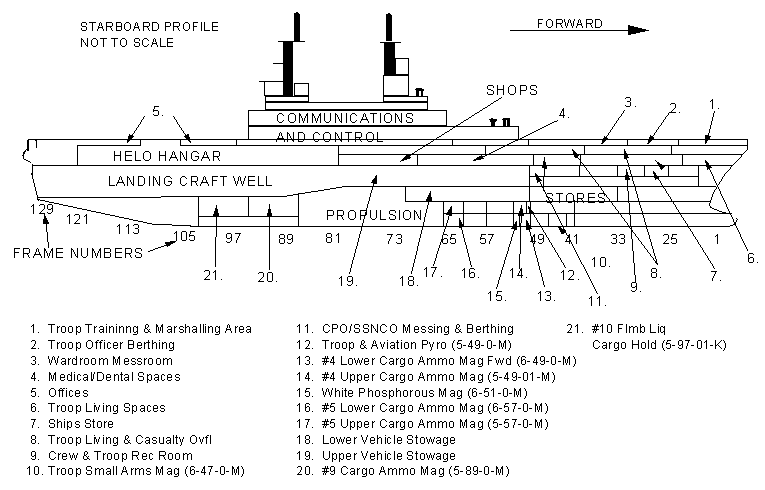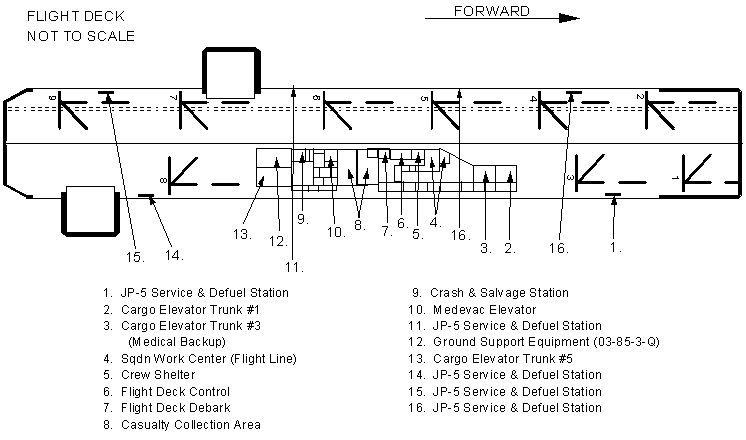

 |
Search the Site with

|

Description:
The WASP class consists of the largest amphibious ships in the world. The LHD is an improved follow-on to the five ship TARAWA class LHAs, sharing the basic hull and engineering plant. The LHD have an enhanced well deck, enabling them to carry three LCACs (vice one LCAC in the LHAs). The flight deck and elevator scheme is also improved, allowing the ship to carry two more helicopters than its predecessor, the LHA.
WASP class ships are the first to be specifically designed to accommodate the
Mission:
These ships conduct prompt, sustained combat operations at sea as the centerpiece of the Navy's amphibious strategy of "Forward ... From the Sea." They provide the means to deliver, command and support all elements of a Marine Landing Force in an assault by air and amphibious craft. In carrying out their mission, the ships have the option of utilizing various combinations of helicopters, Harrier II (
WASP class ships can also provide command and control and aircraft facilities for sea control missions, while operating with an aircraft carrier battle group. They transport and land ashore not only troops, but also the tanks, trucks, jeeps, other vehicles, artillery, ammunition and various supplies necessary to support the amphibious assault mission.
Features:
WASP class ships are 844 feet long with a beam of 106 feet. Two steam propulsion plants, the largest in the Navy, develop 70,000 shaft horsepower for each of the two propulsion shafts. These plants allow the 40,500 ton ship to reach speeds greater than 20 knots. The ship's two propulsion plants generate a total of 400 tons of steam per hour. If the energy of the two boilers were converted to electrical power, it could power a city of 160,000. Electrical generators aboard the ship provide more than 16,000 kilowatts of power for shipboard systems. Two pumping stations give the ship a 450,000 gallon fueling capacity for embarked aircraft and other vehicles. Onboard distilling plants provide up to 200,000 gallons of fresh water each day. Each WASP class ship has accommodations for 3,000 troops and crew members. The ship's crew consists of 98 officers and 983 enlisted personnel. The ships have six fully equipped operating rooms and a 600 bed hospital, by far the largest at sea with the exception of hospital ships.
Monorail trains, moving at speeds up to 600 feet per minute, transport cargo and supplies from storage and staging areas throughout the ship to a 13,600 square foot well deck which opens to the sea through huge gates in the ship's stern. There, the cargo, troops and vehicles are loaded aboard landing craft for transit to the beach. Air cushion landing craft can "fly" out of the dry well deck; or the well deck can be ballasted down for conventional craft to float out on their way to the assault area. Helicopter flights also transfer troops and equipment to the beach, while the ship's air traffic control capability simultaneously directs close air tactical support provided by embarked jet aircraft and helicopter gunships.
History:
Ships of the LHD 1 multipurpose amphibious assault ship program are named for famous U.S. Navy warships which themselves were not named for battles. In naming LHD 1 "WASP," the Navy honors nine previous ships, dating to the American Revolution, which have borne this illustration name. In February 1984, Ingalls Shipbuilding in Pascagoula, Miss., was awarded the contract to build the lead ship of the LHD 1 class, USS Wasp, which was commissioned June 24, 1989 in Norfolk, Virginia. The second LHD was awarded in September 1986 in a competitive bid, also to Ingalls, as a single ship with options, which were awarded in 1988 and 1989. In December 1991, Ingalls won a major competition to build a fifth LHD. That contract included an option exercised with Ingalls in December 1992 for the construction of LHD 6, and an option exercised in December 1995 for the construction of LHD 7.
 (from www.fas.org)
(from www.fas.org) (from www.fas.org)
(from www.fas.org)| General Characteristics - Wasp class | |||||||||||||||||||||
|---|---|---|---|---|---|---|---|---|---|---|---|---|---|---|---|---|---|---|---|---|---|
| Builder: | Ingalls Shipbuilding, Pascagoula, Miss. | ||||||||||||||||||||
| Power Plant: | 2 boilers, 2 geared stream turbines, 2 shafts, 70,000 total shaft horsepower | ||||||||||||||||||||
| Propellers: | two (16,5 feet diameter, six blades) | ||||||||||||||||||||
| Length: | 844 feet (253.2 meters) | ||||||||||||||||||||
| Beam: | 106 feet (31.8 meters) | ||||||||||||||||||||
| Flight Deck Width: | 140 feet (42.6 meters) | ||||||||||||||||||||
| Draft: | 26,5 feet (8.1 meters) | ||||||||||||||||||||
| Displacement: | approx. 40,500 tons full load | ||||||||||||||||||||
| Speed: | 23 knots | ||||||||||||||||||||
| Range: | 9,500 nautical miles @ 20 knots | ||||||||||||||||||||
| Well Deck Capacity: | 3 LCAC or 2 LCU or 6 LCM-8 or 40 Amphibious Assault Vessels (AAV) (normal) or 61 AAVs (stowed) | ||||||||||||||||||||
| Aircraft Elevators: | two 70,000 lbs lift capacity | ||||||||||||||||||||
| Ship's Fuel Capacity: | 1,872,831 gallons | ||||||||||||||||||||
| Aviation Fuel Capacity: | 439,544 gallons | ||||||||||||||||||||
| Crew: | Ship's company: 98 officers and 983 enlisted Marine detachment: about 2,000 | ||||||||||||||||||||
| Armament: | 2 NATO 2 2 8 .50 cal machine guns | ||||||||||||||||||||
| Sensors: | one AN/SPS-48 radar one AN/SPS-49 radar one AN/SPS-64 radar one AN/SPS-67 radar AN/SLQ-32(V)3 Electronic Warfare Systems AN/SLQ-25 NIXIE Towed Torpedo Countermeasures AN/SLQ-49 Chaff Bouys MK-36 Chaff Launcher one MK-23 Target Acquisition System (TAS) AN/SYS-2 Detection/Tracking System MK-91 Fire Control System | ||||||||||||||||||||
| Aircraft: | (The aircraft mix depends upon mission.)
| ||||||||||||||||||||
| Date deployed: | July 29, 1989 (USS Wasp) | ||||||||||||||||||||
 Back to Amphibious Assault Ship List.
Back to Amphibious Assault Ship List.  Back to Ships List.
Back to Ships List.  Back to Selection Page.
Back to Selection Page.  Back to 1st Page.
Back to 1st Page.